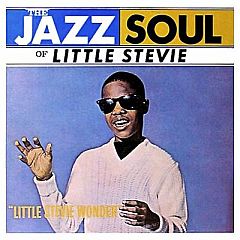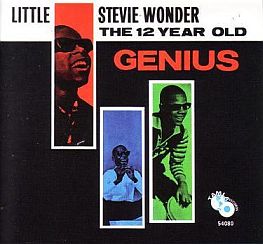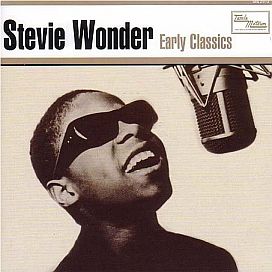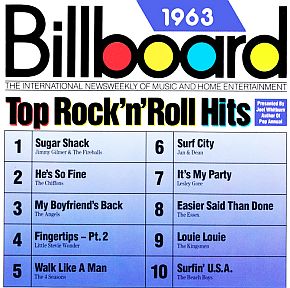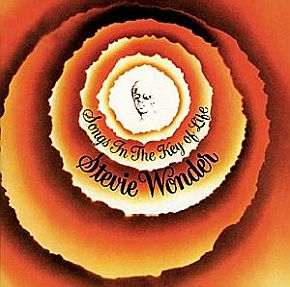The clear, calling harmonica was the sound that first got your attention; it was coming from a new piece of music being played on the radio in late summer 1963. That was the summer of Martin Luther King’s “I Have A Dream” speech; the summer preceding John F. Kennedy’s assassination.
Music Player
“Fingertips, Pt.2”- Stevie Wonder
Recorded Live-1963
The harmonica in the air those days was from a song that had an unusual name: “Fingertips,” or more precisely, “Fingertips, Pt. 2.”
“Fingertips, Pt.2” was like nothing else at the time; part of a distinctive mix of music and vocals, a song recorded live with an unusual arrangement. And it was performed by a 12 year-old blind boy. “Little Stevie Wonder” they called him; a Detroit kid who had a sixth sense about him; a kid who could, it was said, discern a coin’s identity by the sound it made when dropped on a kitchen table.
Stevie Wonder was born Steveland Judkins in May 1950 in Saginaw, Michigan, later known as Steveland Morris after his mother’s married name. Placed in an incubator immediately after birth, baby Steveland was given too much oxygen, leading to permanent blindness in childhood.
Growing up as a blind child, young Stevie developed an affinity for musical instruments, playing the harmonica at five, taking piano lessons at six, and playing drums at eight. After his family moved to Detroit, he began singing and playing instruments in church, including the piano, harmonica, and bongo drums. With a transistor radio to his ear, he also listened to Ray Charles and Sam Cook. In 1961, at the age of 11, the young boy and his mother were introduced to Brian Holland and Berry Gordy of Motown records through Ronnie White of the singing group The Miracles. After an audition, Motown signed the boy to a contract, giving him the stage name Little Stevie Wonder.
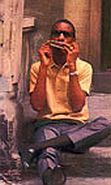
Stevie & harmonica.
DJs Liked Pt. 2
Radio DJs for some reason began playing the 7-minute version of “Fingertips” on the album, which was quite unusual since songs of more than 3 minutes were rarely played on the radio. The DJs especially liked the second part of “Fingertips,” labeled “Fingertips Pt. 2,” which seemed to capture the frantic energy of a live concert. Seeing how the DJs were reacting to the song, Berry Gordy decided to issue it as a shortened 45 rpm single, with “Fingertips Pt 1” on one side, and “Fingertips Pt 2” on the other side. By early August 1963, “Fingertips” became Motown’s second #1 hit. The Marvelettes’ “Please Mr. Postman” had been Motown’s first #1 record, topping the charts in late 1961. “Fingertips Pt 2”, in fact, became the first live, non-studio recording to reach #1 on the Billboard pop singles chart. The live song, with full instrumentation behind it, also had some “call-and-response” sections, complete with audience participation, as in the excerpt below:
Stevie: Evvybody say yeah,…
Audience: Yeah…
Stevie: Everbody say yeah, yeah, yeah …
Audience: Yeah, Yeah, Yeah…
Stevie: Clap yo’ hands just a little bit louder…
Audience: [Clapping rhythmically]….
But the harmonica solos in the live version were full of energy and the novel arrangement caught the attention and enthusiasm of DJs and listeners. “Fingertips” held the #1 spot on the pop charts for three weeks. The song also reached #1 on the R&B singles chart and the album made history as well. Little Stevie Wonder became the first artist to have a #1 album and #1 single simultaneously. He also holds the record for the youngest artist (age 13) to have an album go to #1 on the charts, eventually selling over a million copies.
Path to Stardom
“Fingertips Pt. 2.” put Stevie Wonder on a musical career path that would take him to stardom and a prolific 40-plus years of making and writing music. But not right away. After the novelty of “Fingertips” wore off, a follow-up hit did not come for Stevie. Although he managed to chart a few more singles over the next year, none had the success of “Fingertips.” His voice also changed, and his recording career was temporarily put on hold. He then studied classical piano at the Michigan School for the Blind. On his return in 1964, he dropped “Little” from his stage name and in 1965 had a successful Motown dance tune, “Uptight, Everything’s Alright,” which he co-wrote. That song hit #1 on R&B chart and # 5 on the pop chart. Stevie Wonder was on his way. Through the1960s and 1970s other hits came, among them: “Nothing’s Too Good for My Baby,” Bob Dylan’s “Blowin’ in the Wind”, and Ron Miller’s “A Place in the Sun”– all in 1966. He also wrote music for others, including The Miracles’ #1 hit of 1967, “Tears of a Clown,” co-authored with his producer, Hank Crosby. But there were other Stevie Wonder hits too, including: “I Was Made to Love Her”(1967), “For Once in My Life”(1968), “My Cherie Amour”(1969), and “Signed, Sealed, Delivered I’m Yours”(1970), a song from the first album he produced.
Up to this point, Wonder was still a minor under the law and Motown managed his career, controlling his publishing and recording sessions and keeping his money in a trust fund. By 1971, however, that changed when Stevie turned 21, taking control of $1 million then in his trust fund (some say he had earned $30 million for Motown by that time). He also began negotiating a new contract with Motown. The 21-page contract he negotiated set precedent there, and gave Wonder complete creative control over his music as well as a higher royalty rate, with Motown still distributing his product.
1974-1975
Ten Grammys
In 1972, he gained a broader national audience by opening for the Rolling Stones on their major U.S. tour that year, where he unveiled the soon-to-be #1 hit “Superstition.” Albums in 1972 and 1973 followed. Then he won five Grammy awards in 1974, and five more the following year. He was now an established rock star and had become a multi-millionaire. His 1976 contract with Motown for $13 million over seven years was then the largest in recording history.His 1976 contract with Motown for $13 million over seven years was the largest in recording history at that time. By then, he had 20 hit singles to his credit and eleven best-selling albums. Yet three more decades of music-making still lay ahead, with more hits and more renown, including some unique collaborations, such as 1982’s “Ebony And Ivory” with Paul McCartney, which remained #1 for seven weeks. In 1986, The New York Times – noting his wide ranging skills in several genres, from funk to ballads, bossa nova to quasi-showtunes – called him “a one-man Tin Pan Alley.” In the 1980s and 1990s he also found time to become engaged in children’s and civil-rights causes, and led the campaign to make Martin Luther King’s birthday a national holiday. His music has also paid tribute to figures like King and jazz great Duke Ellington.
|
Stevie Wonder Hits 1963 “Fingertips – Pt. 2” |
Collaborator & Innovator
Known as a musician who has influenced the work of many other artists, Stevie Wonder has also collaborated with a number of his musical colleagues, including Prince, Michael Jackson, Dionne Warwick, Elton John, Julio Iglesias, the Eurythmics, Babyface, Angie Wood and others.
Stevie Wonder provided the harmonica on Elton John’s “I Guess That’s Why They Call It The Blues.” He has also written over 100 songs for fellow artists.
Wonder’s writing and performing over the years has been distinguished for its novel and complicated musical style and its jazz influences. In the former TV program, American Idol, contestants who attempted to cover his songs, for example, found them difficult to perform, as they used unusual chords, make abrupt, unpredictable changes, and often require that a syllable be sung over several notes. Wonder’s selection of musical key – sometimes using the black notes on the piano or keyboard, for example — is more often found in jazz than in pop, but he has used it to great success. He has been a musical innovator throughout his career, playing an important role in bringing synthesizers and electronic keyboards to pop music.
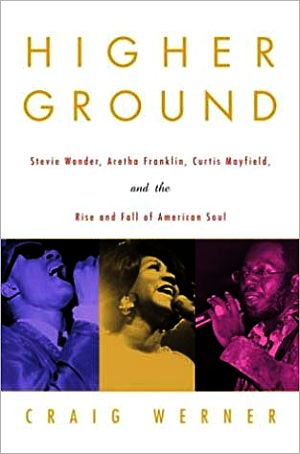
Craig Werner’s 2004 book, “Higher Ground: Stevie Wonder, Aretha Franklin, Curtis Mayfield and the Rise and Fall of American Soul,” Crown Books, 352pp. Click for book.
Songwriter, Producer
Today, Stevie Wonder is among the giants in the music industry; an accomplished singer, songwriter, musician, and record producer. In the U.S., he has had at least nine #1 hits and more than 30 top ten hits. In August 2007, he under-took his first U.S. concert tour in over a decade, performing in a dozen U.S. cities and Toronto, Canada.
During his career, Stevie Wonder’s album and single sales have exceeded the 100 million mark and he has received numerous awards and honors. He is the recipient of 25 Grammy Awards — a record for a solo artist — and has also received a Grammy lifetime achievement award. In 1984, he won an Oscar for Best Song — “I Just Called to Say I Love You” — from the film, The Woman in Red. In 1989 he was inducted into the Rock and Roll Hall of Fame and in 1999, received Kennedy Center Honors. He is also a member of the Songwriters Hall of Fame. No less a musical authority than the former opera star Luciano Pavarotti once called him a “great, great musical genius.”
Stevie Wonder has come a long way since the early 1960s and the days of “Fingertips, Pt. 2.” Yet the innocence of that early sound, and his “Fingertips” harmonica, still send a good and clear calling, just as it did way back then.
For additional stories at this website on the history of popular music, artist profiles, and selected song analysis, see the “Annals of Music” category page. Thanks for visiting — and if you like what you find here, please make a donation to help support the research and writing at this website. Thank you. — Jack Doyle
|
Please Support Thank You |
__________________________
Date Posted: 21 April 2008
Last Update: 24 April 2019
Comments to: jdoyle@pophistorydig.com
Article Citation:
Jack Doyle, “Fingertips, Pt.2, 1963,”
PopHistoryDig.com, April 21, 2008.
_____________________________
Sources, Links & Additional Information
John S. Wilson, “Big Stevie Wonder Serves Soul at Philharmonic Hall,” New York Times, Saturday, September 27, 1969, p. 24.
“Black, Blind and on Top of Pop,” Time, Monday, April 8, 1974.
Jon Pareles, “Concert: Stevie Wonder,” New York Times, September 28, 1986.
John Rockwell, “Stevie Wonder,” in Anthony De Curtis and James Henke (eds), The Rolling Stone Illustrated History of Rock & Roll, Random House, New York, 1992, pp.293-298.
“Stevie Wonder,” in Holly George-Warren and Patricia Romanowski (eds), The Rolling Stone Encyclopedia of Rock & Roll, Rolling Stone Press, New York, 3rd Edition, 2001, pp. 1079-1081.
Steve Huey, “Stevie Wonder, Biography,”All Music Guide.
“Biography of Stevie Wonder,” About the Artist, The Kennedy Center, Washington D.C.
Ed Hogan, “Fingertips – Pt 2,” Song Review, All Music Guide.
“Stevie Wonder,”Wikipedia.org.
Stevie Wonder Profile at U.K. web site, Soulwalking.
“Stevie Wonder Biography”at Biography.com.
“Stevie Wonder Biography”at Songwriters Hall of Fame.
Stevie Wonder website, StevieWonder.net.
Stevie Wonder U.K. site, StevieWonder.org.
Craig Werner, Higher Ground: Stevie Wonder, Aretha Franklin, Curtis Mayfield and the Rise and Fall of American Soul, 2004, Crown Books, 352pp.
______________________________

